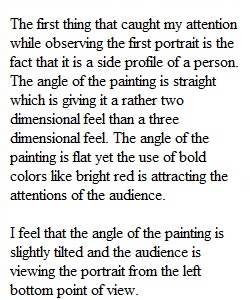


Q We have looked at three pieces of sculpture from the Early Renaissance, High Renaissance, and Baroque periods. Let's now explore how this applies to different art forms, such as painting. We'll look at a similar subject—the human figure—and now we have three figures but each presented in different ways. Please examine the following three portraits from the early Renaissance, the High Renaissance, and the Baroque periods. Without referring to your textbook, rely on what you've learned in previous lessons about Greek and Medieval sculpture and architecture, Renaissance art, as well as the three Davids, to place the portraits in proper historical sequence. And, for the sake of this discussion, let's imagine that you are a historian/archaeologist who is expert in the area of understanding the order of artistic creations. Your expertise comes from being given any set of works, and then being able to determine the order in which they were completed, based on your knowledge of past precedents. Those precedents are the works we've studied so far in this course. They form your guide and your way of reasoning out the order of things. Begin by laying out the sequence, in the order that makes the most sense, from earliest to most recent; and describe why you decided on that particular order. • In order to do this, use terminology and ways of looking that we have been employing in previous lessons when looking at earlier examples of sculpture and architecture. • Refer back to at least one previously discussed example to ground your observations for each of the three works under consideration. This means that you will cite at least three previously studied works. When you cite these works, orient your reader by giving the title, the artist (if applicable), and the period. • Keep in mind that the traits or relationships you find in each painting should also be traits that can be found in the previous examples we've studied (though perhaps in a different form). That is the focus of this discussion: to understand these three paintings with reference back to works we've already studied. • Pay close attention to the positioning/geometry of the subject's body, both in relation to itself and to the picture plane (the actual surface of the painting), and what this says about the three periods. Also, consider the relationship of figure to environment in each example. • Abstract: Relatively closed • Natural: Breaking open • Real: Reaching out • As always, allow yourself to steer clear of negative connotations in describing the works; for some reason, this is especially hard for students to resist with "early" works, but be mindful of it. Just say how each work behaves; how it does what it does; and how each work does what it does in a way that is unique and different from the other examples you are discussing. • Your post should be two to three (well-developed) paragraphs long.
View Related Questions